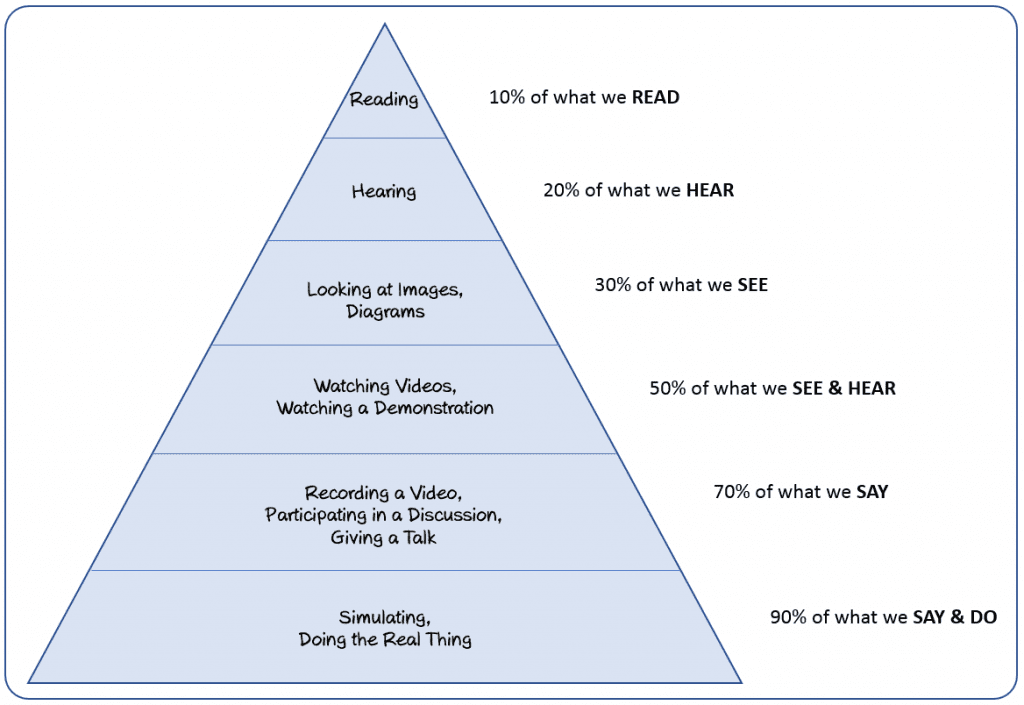As a manager, a thought leader or an educator in your organization, you’re tasked with creating a better workforce, increasing productivity and generally pushing things forward. The challenge is actually not ‘what to do’, but how to find the best way to drive that change, and get everyone on board.
In today’s data-driven business environment, numbers are a great tool to facilitate change. The key is to add quantitative aspects to your qualitative reasoning.
Here is a great way to improve your organization’s learning and training methods, and most importantly, a practical example to advocate that change.
Learning and development is important to a business. Why is that? Because good learning means saving time and increasing employee performance. Since time is money, increased performance typically increases productivity. We all know this is true, and there’s nothing new about it.
In that case, what’s the best way to learn effectively? The answer is visually presented in Edgar Dale’s “Cone of Experience,” which later on was added with numerical values, and was presented as “Cone of Learning”. It basically highlights that a learner will remember information based on the method that information was obtained.
A learner will usually remember:
- 10% of the information if it was read
- 20% of the information if it was heard
- 30% of the information if it was viewed
- 50% of the information if it was heard and viewed
- 70% of the information if it was said
- 90% of the information if it was performed
Information that is heard and viewed can be for example, watching videos or a live demonstration. Information that is said can be for example, participating in a discussion and so on, as the diagram shows.

This model not only shows the effective ways of learning (and the less effective ones, to that matter), but also gives you a way to calculate the return of investment (ROI) for each method.
Easy to understand, and easy to present to all stakeholders, to get everyone on the same page.
Following this model you can realize that giving your employees reading materials isn’t that effective. You’re better off giving them videos to watch, and even better, have them record videos where they need to teach, and showcase the material themselves – have them say it or do it themselves.
Let’s turn this explanation to a real example for a sales-training use-case in an enterprise. Let’s assume you currently have an existing learning course in place for these sales reps, and you also know that adding or replacing this course and tools to a video-based ones will cost you $50,000. The next thing to do is to give your learning content a productivity value. Sales-reps taking the onboarding course, perfectly remembering it and executing on it (our 100%), means they start selling effectively within 1 month of that course. If they remember only 50%, they start selling effectively within 2 months and so on…
In our organization we have 20 sales reps and every month, each sales rep sells $10,000 value.
Take that value, multiply it by the number of learners or sales-reps taking these trainings in our case, and you’ll get the productivity value. In our example, $200,000.
Now you can use the Edgar Dale model and it will help you understand what will happen to that productivity value when you use each one of the different learning techniques.
If you use articles (read) in that course, it will be only 10% effective, you will lose a lot of months selling and your productivity value changes to only $20,000. If you use videos (view) in that course, it will be 50% effective and your productivity value changes to $100,000. And finally if you use video assignments (perform) in that course, it will be 70% effective and your productivity value changes to $140,000. Now, compare that productivity value to the cost of changing or creating new video materials ($50,000), and you see that the video use-cases yield a positive ROI.
This simple model combined with 4th grade math helps you bulletproof your argument. Obviously reality has more grey in it than the black and white presented in models, but the state of mind of adding quantitative factors to the well-known qualitative explanations, is the novel idea we have to adopt in order to get everyone on board. This will help you drive your organization’s growth and show results using video-based learning.
Yair Leshem has many years of product leadership experience in global markets, various industries and a range of technologies – Online Video, SaaS, Enterprise and Higher-Education, Cyber, Mobile and Consumer Electronics. Yair is the Senior Director of Product and Business Development at Kaltura, the leading video technology provider, and helps education institutions and enterprises achieve their goals by using top video products.



































